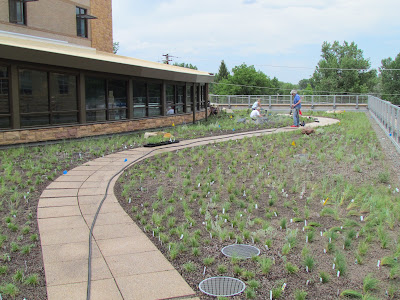All of the plants that will be installed on the Berry Prairie are native to the area around Laramie. Like in the local prairie, grasses will dominate in quantity, but forbs (aka wildflowers) will dominate in diversity. To mimic the native grassland, plant species will be intermixed, avoiding monocultures, while reflecting the natural mixing of species we see in a prairie. For example, a dry area will be planted with cacti, while shrubs will dominate in other areas of the garden, and more mesic species will be grouped together.
The Berry Prairie will be planted with seven species of grasses and one sedge species (3,267 individual plants), about 40 species of herbaceous wildflowers, (approx. 900 individual plants), three species of cacti and one of yucca (60 plants), and approximately 150 shrubs in eight species.
If you weren't counting, that's nearly 4,400 individual plants!
![]() |
Vegetation of the Laramie Basin is largely dominated by grasses, forbs and shrubs.
This is the type of ecosystem the Berry Prairie seeks to mimic on the green roof.
Photo courtesy of the Jackrabbit Goes Down the Rabbit Hole blog.
|
Life on a green roof is tough: it’s hot, it’s constantly sunny, the soil drains quickly so water can be scarce, and the wind is a bully. So, in addition to being native, plants that made the cut also must be very drought tolerant, not require high nutrient availability, and be adapted to high insolation (sun availability and strength). Of course, those traits are generally necessary for survival in the Laramie Basin, which is one reason that we expect local plants to do well on the roof.
The plant list was put together by local experts. A long list of potential roof candidates was compiled from the Rocky Mountain Herbarium database, which has an extensive collection of plants from the Laramie Basin (40,000 or so verified specimens).
Then, many of the selected species were chosen by Dennis Knight, long-time faculty member and now Professor Emeritus of UW Botany Department. Dr. Knight is the author of Mountains and Plains: The Ecology of Wyoming Landscapes, the go-to resource for Wyoming plant ecology. A committee oversaw the plant selection, sourcing and concepts; committee members included:
- Dennis Knight (retired from UW Botany Department),
- Charlotte Belton (designer of the green roof, affiliated with the building architecture firm, Malone Belton Abel),
- Karen Panter (UW Department of Plant Sciences)
- Gracie Lawson Borders (College of Arts and Sciences),
- Bob Mayes (Science and Mathematics Teaching Center),
- Allison Louthan (graduate student in Zoology),
- Craig Benkman (UW Zoology),
- Greg Brown (UW Botany and Berry Center Director),
- Dave Williams (Stable Isotopes Facility faculty director) and
- Kerry Culter (graduate student in Zoology).
![]() |
The first sets of seedlings arrived early this morning, and more are arriving
as we speak. |
Plant Sourcing
Most of the plants that will be installed in The Berry Prairie were procured from commercial growers by the contracted landscaping company.
Charlotte Belton located a source of seeds for some plants the team wanted to try but which weren't available from nurseries. Karen volunteered to grow those at the UW Greenhouses on 30th and Harney Streets in Laramie, just a couple of miles from the Berry Center.
Mark Bede (landscaper) got Karen the seeds at the end of January, many of which had been harvested in Albany County, and some in Carbon County. Karen was able to convince a number of those elusive plants to sprout, but due to shortage of time still have a few that will be installed later this summer once they've reached a suitable size. (Thanks to Charlotte Belton who provided a lot of the plant sourcing information!)
The landscaping company (High Land Inc., of Sheridan), the architecture firm (Malone Belton Abel), and some of the eager Berry Center staff will be installing the green roof plants the all week.
Check back soon for updates!
Written by Brenna Wanous, Berry Center













